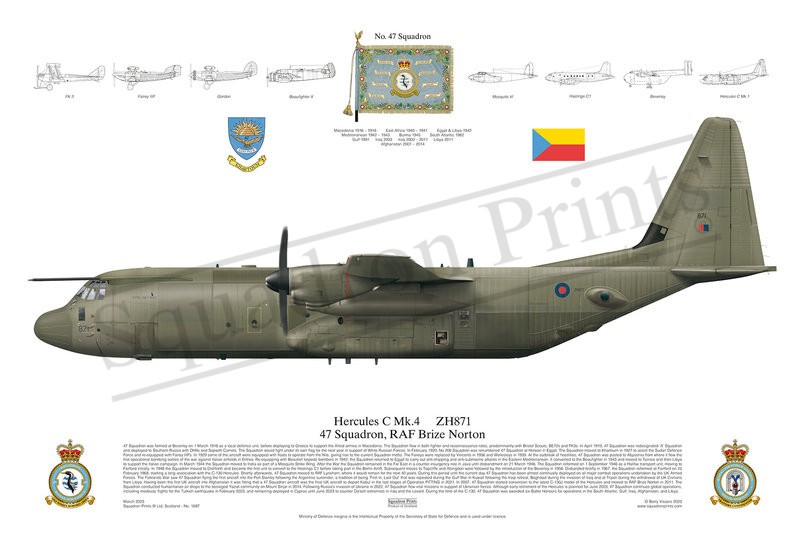#1697 47 Sqn Hercules C4 print

Description
Squadron Prints Lithorgaph No. 1697 - ZH871, Hercules C Mk4, 47 Squadron, RAF Brize Norton.
47 Squadron was formed at Beverley on 1 March 1916 as a local defence unit, before deploying to Greece to support the Allied armies in Macedonia. The Squadron flew in both fighter and reconnaissance roles, predominantly with Bristol Scouts, BE12s and FK3s. In April 1919, 47 Squadron was redesignated ‘A’ Squadron and deployed to Southern Russia with DH9s and Sopwith Camels. The Squadron would fight under its own flag for the next year in support of White Russian Forces. In February 1920, No 206 Squadron was renumbered 47 Squadron at Helwan in Egypt. The Squadron moved to Khartoum in 1927 to assist the Sudan Defence Force and re-equipped with Fairey IIIFs. In 1929 some of the aircraft were equipped with floats to operate from the Nile, giving rise to the current Squadron motto. The Faireys were replaced by Vincents in 1936 and Wellesleys in 1939. At the outbreak of hostilities, 47 Squadron was posted to Abyssinia from where it flew the first operational bombing sorties of the war against Italian airfields in Eritrea. Re-equipping with Beaufort torpedo bombers in 1942, the Squadron returned to Egypt to carry out anti-shipping and anti-submarine attacks in the Eastern Mediterranean. It converted to the Beaufighter in 1943 and moved to Tunisia and then Libya to support the Italian campaign. In March 1944 the Squadron moved to India as part of a Mosquito Strike Wing. After the War the Squadron remained in the Far East in a counter insurgency role in Java until disbandment on 21 March 1946. The Squadron reformed on 1 September 1946 as a Halifax transport unit, moving to Fairford initially. In 1948 the Squadron moved to Dishforth and became the first unit to convert to the Hastings C1 before taking part in the Berlin Airlift. Subsequent moves to Topcliffe and Abingdon were followed by the introduction of the Beverley in 1956. Disbanded briefly in 1967, the Squadron reformed at Fairford on 25 February 1968, starting a long association with the C-130 Hercules. Shortly afterwards, 47 Squadron moved to RAF Lyneham, where it would remain for the next 40 years. During this period until the current day 47 Squadron has been almost continually deployed on all major combat operations undertaken by the UK Armed Forces. The Falklands War saw 47 Squadron flying the first aircraft into the Port Stanley following the Argentine surrender, a tradition of being ‘First In, Last Out’ that was repeated during the Gulf War in Kuwait following the Iraqi retreat, Baghdad during the invasion of Iraq and at Tripoli during the withdrawal of UK Civilians from Libya. Having been the first UK aircraft into Afghanistan it was fitting that a 47 Squadron aircraft was the final UK aircraft to depart Kabul in the last stages of Operation PITTING in 2021. In 2007, 47 Squadron started conversion to the latest C-130J model of the Hercules and moved to RAF Brize Norton in 2011. The Squadron conducted humanitarian air drops to the besieged Yazidi community on Mount Sinjar in 2014. Following Russia’s invasion of Ukraine in 2022, 47 Squadron flew vital missions in support of Ukrainian forces. Although early retirement of the Hercules is planned for June 2023, 47 Squadron continues global operations, including medevac flights for the Turkish earthquake in February 2023, and remaining deployed in Cyprus until June 2023 to counter Da’esh extremists in Iraq and the Levant. During the time of the C-130, 47 Squadron was awarded six Battle Honours for operations in the South Atlantic, Gulf, Iraq, Afghanistan, and Libya.
